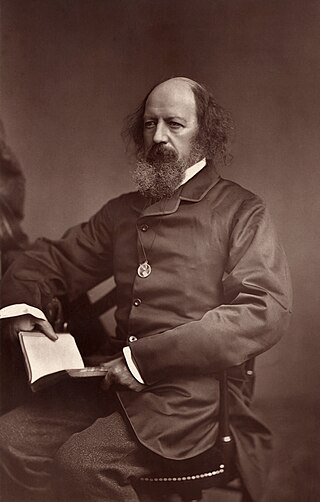
Alfred Tennyson, 1st Baron Tennyson was an English poet. He was the Poet Laureate during much of Queen Victoria's reign. In 1829, Tennyson was awarded the Chancellor's Gold Medal at Cambridge for one of his first pieces, "Timbuktu". He published his first solo collection of poems, Poems, Chiefly Lyrical, in 1830. "Claribel" and "Mariana", which remain some of Tennyson's most celebrated poems, were included in this volume. Although described by some critics as overly sentimental, his verse soon proved popular and brought Tennyson to the attention of well-known writers of the day, including Samuel Taylor Coleridge. Tennyson's early poetry, with its medievalism and powerful visual imagery, was a major influence on the Pre-Raphaelite Brotherhood.
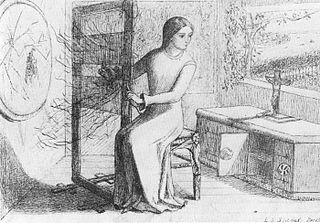
"The Lady of Shalott" is a lyrical ballad by the 19th-century English poet Alfred Tennyson and one of his best-known works. Inspired by the 13th-century Italian short prose text Donna di Scalotta, the poem tells the tragic story of Elaine of Astolat, a young noblewoman stranded in a tower up the river from Camelot. Tennyson wrote two versions of the poem, one published in 1832, of 20 stanzas, the other in 1842, of 19 stanzas, and returned to the story in "Lancelot and Elaine". The vivid medieval romanticism and enigmatic symbolism of "The Lady of Shalott" inspired many painters, especially the Pre-Raphaelites and their followers, as well as other authors and artists.

The poem "In Memoriam A.H.H." (1850) by Alfred, Lord Tennyson, is an elegy for his Cambridge friend Arthur Henry Hallam, who died of cerebral haemorrhage at the age of twenty-two years, in Vienna in 1833. As a sustained exercise in tetrametric lyrical verse, Tennyson's poetical reflections extend beyond the meaning of the death of Hallam, thus, "In Memoriam" also explores the random cruelty of Nature seen from the conflicting perspectives of materialist science and declining Christian faith in the Victorian Era (1837–1901), the poem thus is an elegy, a requiem, and a dirge for a friend, a time, and a place.

Enoch Arden is a narrative poem by Alfred, Lord Tennyson, published in 1864 during his tenure as British poet laureate. The story on which it was based was provided to Tennyson by Thomas Woolner. The poem lends its name to a principle in law that after being missing for a certain number of years a person may be declared dead for purposes of remarriage and inheritance of their survivors.

Elaine of Astolat, also known as Elayne of Ascolat and other variants of the name, is a figure in Arthurian legend. She is a lady from the castle of Astolat who dies of her unrequited love for Sir Lancelot. Well-known versions of her story appear in Sir Thomas Malory's 1485 book Le Morte d'Arthur, Alfred, Lord Tennyson's mid-19th-century Idylls of the King, and Tennyson's poem "The Lady of Shalott". She should not be confused with Elaine of Corbenic, the mother of Galahad by Lancelot.
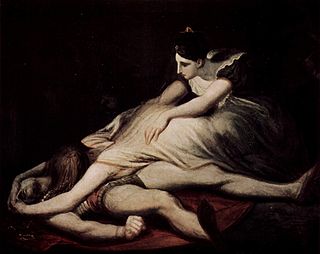
Guðrúnarkviða I or the First Lay of Guðrún is simply called Guðrúnarkviða in Codex Regius, where it is found together with the other heroic poems of the Poetic Edda. Henry Adams Bellows considered it to be one of the finest of the eddic poems with an "extraordinary emotional intensity and dramatic force". It is only in this poem that Gjúki's sister Gjaflaug and daughter Gollrönd are mentioned, and the only source where Herborg, the queen of the Huns, appears. The Guðrún lays show that the hard-boiled heroic poetry of the Poetic Edda also had a place for the hardships of women.

James Francis Harry St Clair-Erskine, 5th Earl of Rosslyn, styled Lord Loughborough until 1890, was a Scottish soldier, author and aristocrat.

"Godiva" is a poem written in 1840 by the poet Alfred, Lord Tennyson when he was returning from Coventry to London, after his visit to Warwickshire in that year. It was first published in 1842. No alteration was made in any subsequent edition.
Violet Fane is the literary pseudonym of Lady Mary Montgomerie Currie. A poet, a writer, and later an ambassadress, who was active in the British literary scene from 1872 until her death in 1905, Fane was a literary celebrity associated with Aestheticism, Medievalism, whose verses were occasionally set to music by composers such as Paolo Tosti and Hermine Küchenmeister-Rudersdorf. As a well-known figure in London society, Fane's coterie included famous literary personas such as Robert Browning, Algernon Swinburne, A. W. Kinglake, Alfred Austin, James McNeil Whistler, Lillie Langtry, and Oscar Wilde, who praised the oracular bent of Fane's opinions on 'the relation of art to nature' by saying that she ‘live[d] between Parnassus and Piccadilly’.

"Mariana" is a poem by Alfred, Lord Tennyson, published in 1830. The poem follows a common theme in much of Tennyson's work—that of despondent isolation. The subject of "Mariana" is a woman who continuously laments her lack of connection with society. The isolation defines her existence, and her longing for a connection leaves her wishing for death at the end of every stanza. The premise of "Mariana" originates in William Shakespeare's Measure for Measure, but the poem ends before Mariana's lover returns. Tennyson's version was adapted by others, including John Everett Millais and Elizabeth Gaskell, for use in their own works. The poem was well received by critics, and it is described by critics as an example of Tennyson's skill at poetry.

"The Deserted House" is a poem written by Alfred, Lord Tennyson in 1830, as part of his collection Poems, Chiefly Lyrical. The poem is characterised by its reliance on short lines which alternate in rhyme and meter to prevent a felicitous feel. In the poem, Tennyson uses the image of a dark house as a metaphor for a dead body.

"Break, Break, Break" is a poem by Alfred, Lord Tennyson written during early 1835 and published in 1842. The poem is an elegy that describes Tennyson's feelings of loss after Arthur Henry Hallam died and his feelings of isolation while at Mablethorpe, Lincolnshire.
The Lady Clare is a 1919 British silent drama film directed by Wilfred Noy and starring Mary Odette, Jack Hobbs and Charles Quatermaine. It is based on the narrative poem Lady Clare by Lord Tennyson.
"Sweet and Low" is a poem by Alfred, Lord Tennyson. Written in 1849, Tennyson sent two versions of the poem to Emily Sellwood in November, asking her to select which one to include in the revised 1850 edition of The Princess, where it intercalates canto II and III.
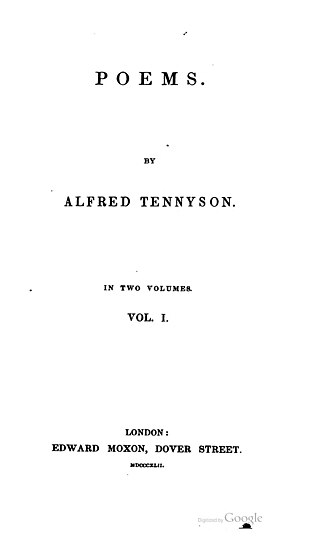
Poems, by Alfred Tennyson, was a two-volume 1842 collection in which new poems and reworked older ones were printed in separate volumes. It includes some of Tennyson's finest and best-loved poems, such as Mariana, The Lady of Shalott, The Palace of Art, The Lotos Eaters, Ulysses, Locksley Hall, The Two Voices, Sir Galahad, and Break, Break, Break. It helped to establish his reputation as one of the greatest poets of his time.

The Laird o' Cockpen is a song written by Carolina Oliphant, Lady Nairne (1766–1845), which she contributed anonymously to The Scottish Minstrel, a six-volume collection of traditional Scottish songs published from 1821 to 1824. Much of the Scottish poetry in Carolina's time was concerned with writing genteel verses for somewhat bawdier earlier songs, and The Laird o' Cockpen is no exception, being set to the music of "O when she cam' ben she bobbit".
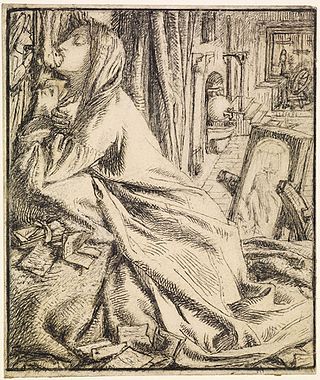
"Mariana in the South" is an early poem by Alfred Tennyson, first printed in 1833 and significantly revised in 1842.

The Miller's Daughter is a narrative poem by Alfred Tennyson, first printed in 1833 and significantly revised in 1842.

"St. Agnes" is a poem by Alfred Tennyson, first published in 1837, revised in 1842, and retitled "St. Agnes' Eve" in 1857.
Poems, Chiefly Lyrical is a poetry collection by Alfred Tennyson, published in June 1830.


















